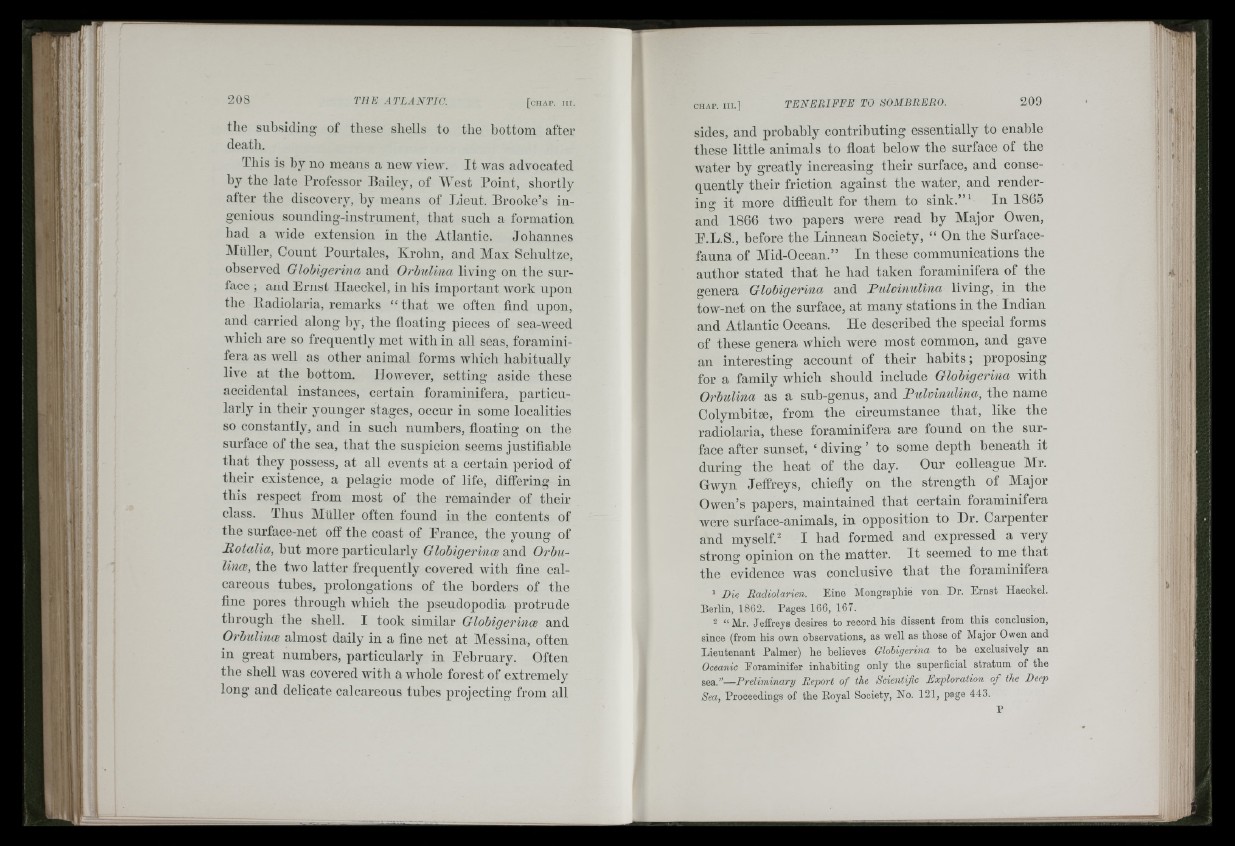
ll.
i
ir
!
■Jj' .!
1 ; ■ i I ■ ’■ I u i • ', i ' k ! 'I?
fT ■ iiI \«iVf
« Ü
‘i)Ii
I
208
the subsiding of these shells to the hottom after
death.
This is by no means a new view. It was advocated
by the late Professor Bailey, of West Point, shortly
after the discovery, hy means of Lieut. Brooke’s ingenious
sounding-instrumeut, that such a formation
had a Avide extension in the Atlantic. Johannes
Muller, Count Pourtales, Krohn, and Max Sclmltze,
observed Glohigerina and Orhulina living on the surface
; and Ernst Haeckel, in his important Avork upon
the Badiolaria, remarks “ tliat we often find upon,
aud carried along l)y, the floating pieces of sea-Aveed
Avhich are so frequently met Avith in all seas, foraminifera
as well as other animal forms Avhich habitually
live at the hottom. However, setting aside these
accidental instances, certain foramiuifera, particularly
in their younger stages, occur in some localities
so constantly, and iu such numbers, floating on the
surface of the sea, that the suspicion seems justifiable
that they possess, at all events at a certain period of
their existence, a pelagic mode of life, differing in
this respect from most of the remainder of their
class. Thus Müller often found iu the contents of
the surface-net off the coast of Erauce, the young of
Botalia, hut more particularly Glohigerince and Orhu-
linw, the tAvo latter frequently covered Avith fine calcareous
tubes, prolongations of the borders of the
fine pores through Avhich the pseudopodia protrude
through the shell. I took similar Glohigerince and
Orhiilinw almost daily iu a fine net at Messina, often
in great numbers, particularly iu Eebruary. Often
the shell Avas covered Avith a AA'hole forest of extremely
long and delicate calcareous tuhes projecting from all
sides, and probably contributing essentially to enable
these little animals to float below the surface of the
water by greatly increasing their surface, and consequently
their friction against the water, aud rendering
it more difficult for them to sink.” ^ In 1865
and 1866 I a v o papers Avere read hy Major Owen,
E.L.S., before the Liuneau Society, “ On the Surface-
fauua of Mid-Ocean.” In these communications the
author stated that he had taken foraminifera of the
genera Globigerina and Pulvinulina living, in the
tow-net on the surface, at many stations iu the Indian
and Atlantic Oceans. He described the special forms
of these genera Avhich were most common, and gave
an interesting account of their habits; proposing
for a family which should include Glohigerina with
Orhulina as a sub-genus, and Pulvinulina, the name
ColymhitEe, from the eircumstauce that, like the
radiolaria, these foramiuifera are found on the surface
after sunset, ‘ diving ’ to some depth beneath it
during the heat of the day. Our colleague Mr.
GAvyn Jeffreys, chiefly ou the strength of Major
Owen’s papers, maintained that certain foramiuifera
were surface-animals, iu opposition to Dr. Carpenter
and myself.^ I had formed and expressed a very
strong opinion ou the matter. It seemed to me that
the evidence was conclusive that the foraminifera
1 Die Radiolarien. Eine Mongraphie von Dr. Ernst Haeckel.
Berlin, 1862. Pages 166, 167.
2 “ Mr. Jeffreys desires to record his dissent from this conclusion,
since (from his own observations, as well as those of Major Owen and
Lieutenant Palmer) he believes Glohigerina to be exclusively an
Oceanic Foraminifer inhabiticg only the superficial stratum of the
sea.”—Preliminary Eeport o f the Scientific Exploration o f tlie Deep
Sea, Proceedings of the Royal Society, No. 121, page 443.
i f '
Ifji
' ';iti; 1J
::llA
i t